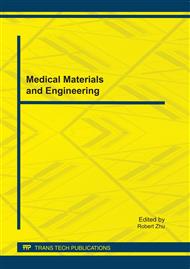[1]
American Cancer Society. Cancer facts and figures 2003. Atlanta, GA:American Cancer Society, (2003).
Google Scholar
[2]
Lancaster JM, Dressman HK, Clarke JP, et al. Identification of genes associated with ovarian cancer metastasis using microarray expression analysis. Int J Gynecol Cancer. (2006);16: 1733–1745.
DOI: 10.1111/j.1525-1438.2006.00660.x
Google Scholar
[3]
Steeg PS. Metastasis suppressors alter the signal transduction of cancer cells. Nat Rev Cancer 2003; 3: 55–63.
DOI: 10.1038/nrc967
Google Scholar
[4]
Welch DR, Hunter KW. A new member of the growing family of metastasis suppressors identified in prostate cancer. J Natl Cancer Inst (2003),95: 839–841.
DOI: 10.1093/jnci/95.12.839
Google Scholar
[5]
Lee JH, Welch DR. Identification of highly expressed genes in metastasis-suppressed chromosome 6/human malignant melanoma hybrid cells using subtractive hybridization and differential display. Int J Cancer (1997)71:1035-1044
DOI: 10.1002/(sici)1097-0215(19970611)71:6<1035::aid-ijc20>3.0.co;2-b
Google Scholar
[6]
Gao GL, Liu LD, Zou XS, et al. Expression of KiSS-1, matrix metalloproteinase-9, nuclear factor-kappaBp65 in ovarian tumour. Zhonghua Fu Chan Ke Za Zhi. (2007)42(1):34-38
Google Scholar
[7]
Hata K, Dhar DK, Watanabe Y,et al.Expression of metastin and a G-protein-coupled receptor (AXOR12) in epithelial ovarian cancer. Eur J Cancer. (2007)43(9):1452-1459.
DOI: 10.1016/j.ejca.2007.03.004
Google Scholar
[8]
Jiang Y, Berk M, Singh LS, et al.KiSS1 suppresses metastasis in human ovarian cancer via inhibition of protein kinase C alpha. Clin Exp Metastasis. (2005); 22 (5):369-376.
DOI: 10.1007/s10585-005-8186-4
Google Scholar
[9]
Ohtaki T, Shintani y, Honda S, et al. Metastasis suppressor gene KiSS-1 encodes peptide ligand of a G-protein-coupled receptor. Nature (2001);411:613-617
DOI: 10.1038/35079135
Google Scholar
[10]
Kotani M, Detheux M, Vandenbogaerde A et al. The metastasis suppressor gene KiSS-1 encodes kisspeptins, the natural ligands of the orphan G protein-coupled receptor GPR54. J Biol Chem 2001; 276: 34631–34636.
DOI: 10.1074/jbc.m104847200
Google Scholar
[11]
Muir AI, Chamberlain L, Elshourbagy NA, et al. AXOR12, a novel human G protein-coupled receptor, activated by the peptide KiSS-1. J Biol Chem (2001); 276: 28969–28975.
DOI: 10.1074/jbc.m102743200
Google Scholar
[12]
Pentheroudakis G, Kostadima L, Dova L, et al. A twisted kiss: in vitro and in vivo evidence of genetic variation and suppressed transcription of the metastasis-suppressor gene KiSS1 in early breast cancer. Neoplasma. (2010);57(1):47-54
DOI: 10.4149/neo_2010_01_047
Google Scholar
[13]
Yoshioka K, Ohno Y, Horiguchi Y, et al. Effects of a KiSS-1 peptide, a metastasis suppressor gene, on the invasive ability of renal cell carcinoma cells through a modulation of a matrix metalloproteinase 2 expression. Life Sci (2008); 83(9-10):332-338.
DOI: 10.1016/j.lfs.2008.06.018
Google Scholar
[14]
Takino T, Koshikawa N, Miyamori H, et al. Cleavage of metastasis suppressor gene product KiSS-1 protein/metastin by matrix metalloproteinases. Oncogene (2003), 22(30):4617-4626
DOI: 10.1038/sj.onc.1206542
Google Scholar
[15]
Makri A, Pissimissis N, Lembessis P,et al. The kisspeptin (KiSS-1)/GPR54 system in cancer biology.Cancer Treat Rev. (2008);34(8):682-692.
DOI: 10.1016/j.ctrv.2008.05.007
Google Scholar
[16]
Nagai K, Doi R, Katagiri F, et al. Prognostic value of metastin expression in human pancreatic cancer.J Exp Clin Cancer Res. (2009) ;21;28-29
DOI: 10.1186/1756-9966-28-9
Google Scholar
[17]
Schmid K, Wang X, Haitel A,et al.KiSS-1 overexpression as an independent prognostic marker in hepatocellular carcinoma: an immunohistochemical study. Virchows Arch.( 2007); 450 (2) : 143-149.
DOI: 10.1007/s00428-006-0352-9
Google Scholar
[18]
Shan W, LIU J. Epithelial ovarian cancer: focus on genetics and animal models. Cell Cycle. (2009) ;8(5):731-735.
DOI: 10.4161/cc.8.5.7848
Google Scholar


